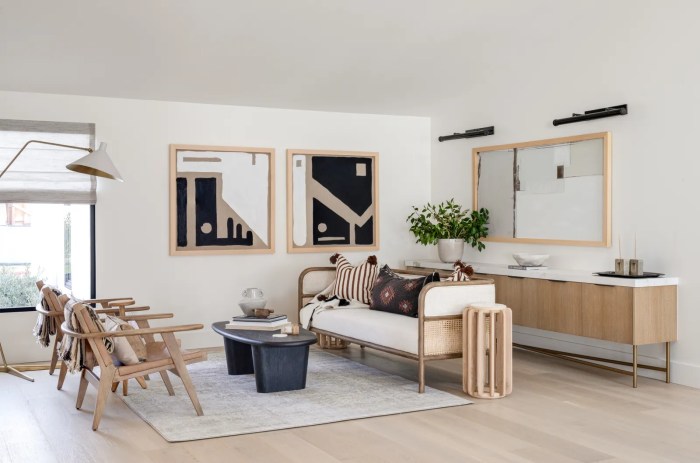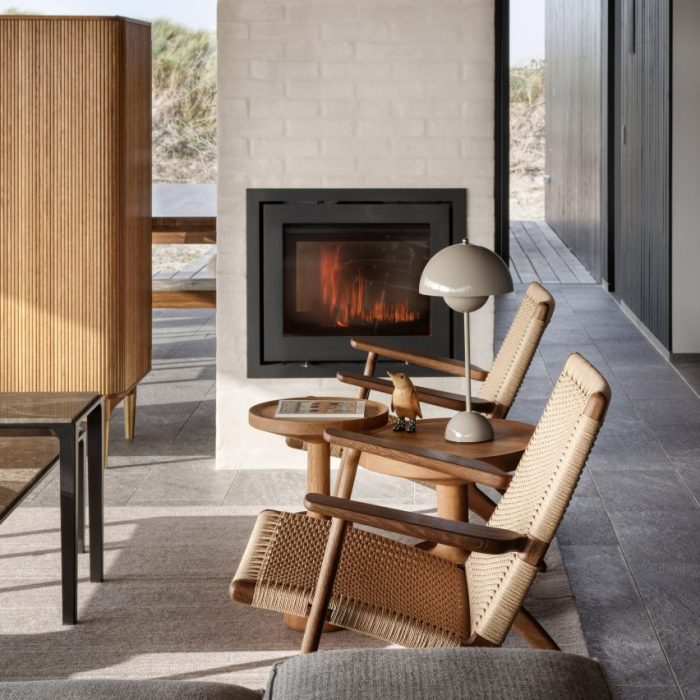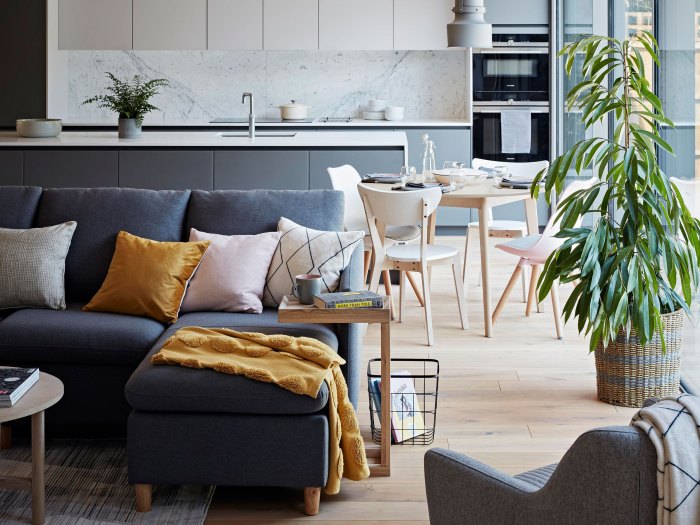Embark on a journey through the world of Danish interior design, where elegance meets functionality in a harmonious blend. From minimalist furniture to sustainable practices, Danish design has captivated the hearts of many.
Delve into the origins, elements, color palettes, iconic furniture designers, and sustainability practices that define Danish interior design. Discover how this design style has evolved over the years, leaving a lasting impact on the global design industry.
History of Danish Interior Design
Denmark has a rich history of interior design dating back to the early 20th century, with a focus on simplicity, functionality, and craftsmanship. Danish design has been influenced by various movements such as Bauhaus and Modernism, shaping its unique aesthetic.
Origins of Danish Interior Design
Danish interior design emerged in the 1920s and 1930s, influenced by the functionalist movement and the principles of Bauhaus. Designers like Kaare Klint and Poul Henningsen played a significant role in shaping the Danish design aesthetic, focusing on clean lines, minimalism, and quality craftsmanship.
Key Characteristics of Danish Interior Design
Minimalism
Danish design is known for its minimalist approach, with a focus on clean lines and simplicity.
Functionality
Functionality is a key aspect of Danish design, with furniture and decor serving a practical purpose while being aesthetically pleasing.
Quality Craftsmanship
Danish designers place a strong emphasis on quality craftsmanship, using natural materials like wood and leather.
Evolution of Danish Interior Design
Over the years, Danish interior design has evolved to incorporate new materials, colors, and forms while still maintaining its core principles of simplicity and functionality. Designers like Arne Jacobsen and Hans Wegner have continued to push the boundaries of Danish design, creating iconic pieces that are still popular today.
Elements of Danish Interior Design

When it comes to Danish interior design, there are several key elements that define this style. From minimalist furniture to the use of natural materials, Danish design is known for its clean lines and functional yet aesthetically pleasing approach.
Minimalist Furniture
In Danish interior design, less is often more. Minimalist furniture with simple and clean lines is a hallmark of this style. Pieces are typically functional, practical, and beautifully crafted, focusing on quality over quantity.
Clean Lines
Clean lines play a crucial role in Danish interior design, creating a sense of harmony and balance in a space. Furniture and decor pieces are often sleek and uncluttered, contributing to a minimalist aesthetic that is both timeless and elegant.
Natural Materials
Danish design embraces the use of natural materials such as wood, leather, and wool. These elements bring warmth and texture to a space, adding a sense of coziness and inviting atmosphere. Sustainability is also a key consideration, with a focus on eco-friendly materials and production methods.
Significance of Lighting
Lighting is a crucial aspect of Danish interior design, as it can greatly influence the mood and ambiance of a room. Natural light is often maximized through large windows and strategically placed light fixtures. Soft, warm lighting is preferred to create a cozy and inviting atmosphere.
Functionality and Aesthetics
Danish interior design seamlessly combines functionality with aesthetics. Every piece of furniture or decor serves a purpose while also contributing to the overall look and feel of the space. The focus is on creating a harmonious and well-balanced environment that is both practical and visually appealing.
Color Palette in Danish Interior Design
In Danish interior design, the color palette is carefully curated to reflect the principles of simplicity, functionality, and coziness.
Neutral Tones Dominance
Neutral tones such as whites, creams, grays, and beiges are commonly used as the base colors in Danish interiors. These hues create a calm and serene atmosphere, allowing other elements in the room to stand out.
Pops of Color for Contrast
To add visual interest and warmth to the space, Danish interior design often incorporates pops of color in the form of textiles, artwork, or furniture pieces. These vibrant accents complement the neutral backdrop and infuse personality into the room.
Creating Hygge through Colors
The concept of 'hygge' is central to Danish design, emphasizing coziness and comfort
Furniture Design in Danish Interior Design
When it comes to Danish interior design, furniture plays a crucial role in defining the aesthetic and functionality of a space. Iconic Danish furniture designers like Hans Wegner and Arne Jacobsen have left a lasting impact on the design world with their innovative creations.
Iconic Danish Furniture Designers
Denmark is known for producing some of the most influential furniture designers in the world. Hans Wegner, often referred to as the "master of the chair," created timeless pieces that seamlessly blend form and function. Arne Jacobsen, on the other hand, is famous for his minimalist yet functional designs that have stood the test of time.
Characteristics of Danish Furniture Design
- Danish furniture design is characterized by its emphasis on craftsmanship and attention to detail. Each piece is meticulously crafted to ensure the highest quality and durability.
- The use of quality materials is another hallmark of Danish furniture design. Designers often opt for natural materials like wood, leather, and wool, which not only enhance the aesthetic appeal but also contribute to the longevity of the furniture.
- Simplicity and functionality are key features of Danish furniture design. Pieces are designed to be practical and comfortable without compromising on style.
Influence of Danish Furniture Design
Danish furniture design has had a significant influence on the global design industry. The clean lines, organic shapes, and timeless appeal of Danish furniture have inspired designers around the world. The focus on quality craftsmanship and sustainable materials has also shaped the way furniture is produced and perceived on a global scale.
Sustainability in Danish Interior Design

In Danish interior design, sustainability plays a crucial role in the creation of eco-friendly and environmentally conscious spaces. Danish designers are known for their commitment to incorporating sustainable practices into their work, focusing on using recycled materials, organic fabrics, and energy-efficient solutions to reduce their environmental impact.
Incorporating Sustainable Practices
- Danish designers prioritize using recycled materials such as wood, metal, and glass in their furniture and decor pieces. By giving new life to these materials, they reduce waste and promote a circular economy.
- Organic fabrics like linen, hemp, and organic cotton are commonly used in Danish interior design to minimize the use of harmful chemicals and pesticides in production processes.
- Energy-efficient lighting, heating, and cooling systems are integrated into Danish interiors to reduce energy consumption and lower carbon emissions.
Use of Recycled Materials and Organic Fabrics
Danish interior designers often source materials from sustainable suppliers and manufacturers who prioritize ethical and eco-friendly production methods. By choosing recycled materials and organic fabrics, they not only contribute to a healthier environment but also support responsible and transparent supply chains.
The use of these sustainable materials adds unique textures and finishes to Danish interiors, creating a harmonious blend of style and sustainability.
Ending Remarks

In conclusion, Danish interior design embodies a unique blend of timeless elegance and sustainable practices. With a focus on minimalist aesthetics, natural materials, and functionality, Danish design continues to inspire and influence the world of interior decor.
Commonly Asked Questions
What are some key characteristics of Danish interior design?
Danish interior design is known for its minimalist furniture, clean lines, natural materials, and emphasis on functionality.
How do Danish designers incorporate sustainability into their work?
Danish designers often use recycled materials, organic fabrics, and eco-friendly practices to ensure sustainability in their designs.
Who are some iconic Danish furniture designers?
Iconic Danish furniture designers include Hans Wegner and Arne Jacobsen, known for their craftsmanship and use of quality materials.
